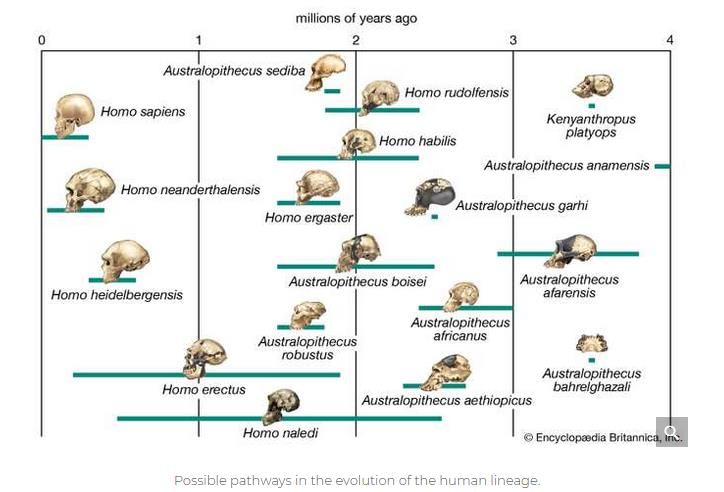Humanities/Arts Exam > Humanities/Arts Questions > Give a flow chart on human evolution from the...
Start Learning for Free
Give a flow chart on human evolution from the chapter “From the beginning of time”.?
Verified Answer
Give a flow chart on human evolution from the chapter “From the beginn...
Ans.

 This question is part of UPSC exam. View all Humanities/Arts courses
This question is part of UPSC exam. View all Humanities/Arts courses
Most Upvoted Answer
Give a flow chart on human evolution from the chapter “From the beginn...

Community Answer
Give a flow chart on human evolution from the chapter “From the beginn...
Flow Chart: Human Evolution
1. Introduction
- Human evolution is the biological and cultural development of Homo sapiens from their ancestors.
- It is a complex process that spans millions of years and involves various stages of evolution.
2. Early Hominins
- The first hominins emerged in Africa around 6-7 million years ago.
- Key species include Sahelanthropus tchadensis, Orrorin tugenensis, and Ardipithecus ramidus.
- These early hominins had a mix of ape-like and human-like features.
3. Australopithecines
- Australopithecus afarensis, such as the famous fossil "Lucy," lived between 3-4 million years ago.
- They walked upright but still had some arboreal adaptations.
- Australopithecines were the first hominins to show significant brain expansion.
4. Homo habilis
- Homo habilis, meaning "handy man," lived around 2-1.6 million years ago.
- They were the first hominins to use stone tools, indicating increased cognitive abilities.
- Homo habilis had a larger brain than Australopithecines and a more human-like body structure.
5. Homo erectus
- Homo erectus emerged around 2 million years ago and spread throughout Africa, Asia, and Europe.
- They had larger brains and more advanced tool-making skills.
- Homo erectus was the first hominin species to migrate out of Africa.
6. Neanderthals
- Neanderthals lived in Europe and parts of Asia from about 400,000 to 40,000 years ago.
- They had a robust build, large brains, and exhibited complex social behaviors.
- Neanderthals coexisted with early Homo sapiens and interbred with them.
7. Homo sapiens
- Homo sapiens evolved in Africa around 300,000 years ago.
- They had a more gracile body structure, larger brains, and advanced cognitive abilities.
- Homo sapiens gradually spread across the globe and became the only surviving human species.
8. Modern Humans
- Modern humans, anatomically similar to present-day humans, emerged around 200,000 years ago.
- They developed advanced tools, art, language, and complex societies.
- Modern humans continued to evolve biologically and culturally, leading to the diverse populations we see today.
9. Conclusion
- Human evolution is a continuous and ongoing process.
- The flow chart highlights the major milestones and species in our evolutionary journey.
- Understanding human evolution helps us comprehend our place in the natural world and provides insights into our shared ancestry.
1. Introduction
- Human evolution is the biological and cultural development of Homo sapiens from their ancestors.
- It is a complex process that spans millions of years and involves various stages of evolution.
2. Early Hominins
- The first hominins emerged in Africa around 6-7 million years ago.
- Key species include Sahelanthropus tchadensis, Orrorin tugenensis, and Ardipithecus ramidus.
- These early hominins had a mix of ape-like and human-like features.
3. Australopithecines
- Australopithecus afarensis, such as the famous fossil "Lucy," lived between 3-4 million years ago.
- They walked upright but still had some arboreal adaptations.
- Australopithecines were the first hominins to show significant brain expansion.
4. Homo habilis
- Homo habilis, meaning "handy man," lived around 2-1.6 million years ago.
- They were the first hominins to use stone tools, indicating increased cognitive abilities.
- Homo habilis had a larger brain than Australopithecines and a more human-like body structure.
5. Homo erectus
- Homo erectus emerged around 2 million years ago and spread throughout Africa, Asia, and Europe.
- They had larger brains and more advanced tool-making skills.
- Homo erectus was the first hominin species to migrate out of Africa.
6. Neanderthals
- Neanderthals lived in Europe and parts of Asia from about 400,000 to 40,000 years ago.
- They had a robust build, large brains, and exhibited complex social behaviors.
- Neanderthals coexisted with early Homo sapiens and interbred with them.
7. Homo sapiens
- Homo sapiens evolved in Africa around 300,000 years ago.
- They had a more gracile body structure, larger brains, and advanced cognitive abilities.
- Homo sapiens gradually spread across the globe and became the only surviving human species.
8. Modern Humans
- Modern humans, anatomically similar to present-day humans, emerged around 200,000 years ago.
- They developed advanced tools, art, language, and complex societies.
- Modern humans continued to evolve biologically and culturally, leading to the diverse populations we see today.
9. Conclusion
- Human evolution is a continuous and ongoing process.
- The flow chart highlights the major milestones and species in our evolutionary journey.
- Understanding human evolution helps us comprehend our place in the natural world and provides insights into our shared ancestry.

|
Explore Courses for Humanities/Arts exam
|

|
Similar Humanities/Arts Doubts
Question Description
Give a flow chart on human evolution from the chapter “From the beginning of time”.? for Humanities/Arts 2025 is part of Humanities/Arts preparation. The Question and answers have been prepared according to the Humanities/Arts exam syllabus. Information about Give a flow chart on human evolution from the chapter “From the beginning of time”.? covers all topics & solutions for Humanities/Arts 2025 Exam. Find important definitions, questions, meanings, examples, exercises and tests below for Give a flow chart on human evolution from the chapter “From the beginning of time”.?.
Give a flow chart on human evolution from the chapter “From the beginning of time”.? for Humanities/Arts 2025 is part of Humanities/Arts preparation. The Question and answers have been prepared according to the Humanities/Arts exam syllabus. Information about Give a flow chart on human evolution from the chapter “From the beginning of time”.? covers all topics & solutions for Humanities/Arts 2025 Exam. Find important definitions, questions, meanings, examples, exercises and tests below for Give a flow chart on human evolution from the chapter “From the beginning of time”.?.
Solutions for Give a flow chart on human evolution from the chapter “From the beginning of time”.? in English & in Hindi are available as part of our courses for Humanities/Arts.
Download more important topics, notes, lectures and mock test series for Humanities/Arts Exam by signing up for free.
Here you can find the meaning of Give a flow chart on human evolution from the chapter “From the beginning of time”.? defined & explained in the simplest way possible. Besides giving the explanation of
Give a flow chart on human evolution from the chapter “From the beginning of time”.?, a detailed solution for Give a flow chart on human evolution from the chapter “From the beginning of time”.? has been provided alongside types of Give a flow chart on human evolution from the chapter “From the beginning of time”.? theory, EduRev gives you an
ample number of questions to practice Give a flow chart on human evolution from the chapter “From the beginning of time”.? tests, examples and also practice Humanities/Arts tests.

|
Explore Courses for Humanities/Arts exam
|

|
Signup to solve all Doubts
Signup to see your scores go up within 7 days! Learn & Practice with 1000+ FREE Notes, Videos & Tests.





















